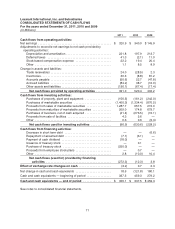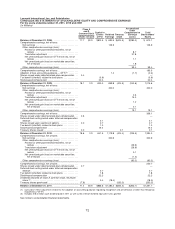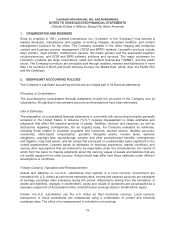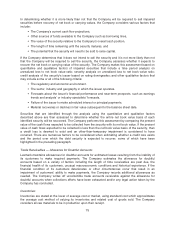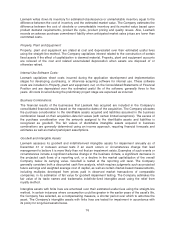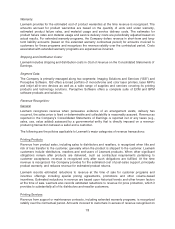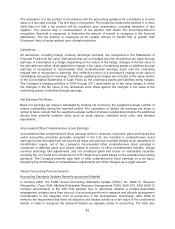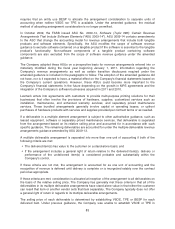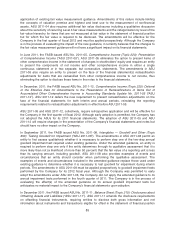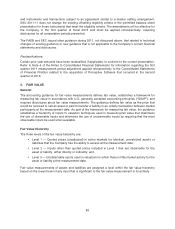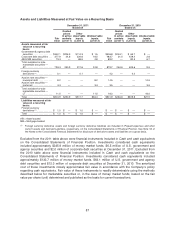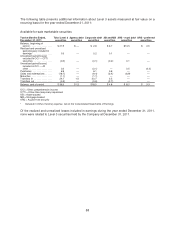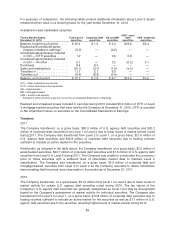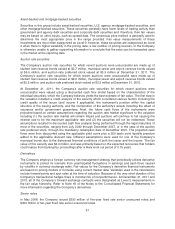Lexmark 2011 Annual Report Download - page 85
Download and view the complete annual report
Please find page 85 of the 2011 Lexmark annual report below. You can navigate through the pages in the report by either clicking on the pages listed below, or by using the keyword search tool below to find specific information within the annual report.on the date of grant. Under the terms of the Company’s RSU agreements, unvested RSU awards
contain forfeitable rights to dividend equivalent units. The fair value of each dividend equivalent unit
(“DEU”) was calculated using the closing price of the Company’s stock on the date of the dividend
payment.
The Company elected to adopt the alternative transition method provided in the guidance for
calculating the tax effects of stock-based compensation pursuant to the adoption of the share-based
payment guidance. The alternative transition method includes simplified methods to establish the
beginning balance of the additional paid-in capital pool (“APIC pool”) related to the tax effects of
employee stock-based compensation, and to determine the subsequent impact on the APIC pool and
Consolidated Statement of Cash Flows of the tax effects of employee stock-based compensation
awards that are outstanding upon the adoption of the share-based payment guidance.
Restructuring:
Lexmark records a liability for a cost associated with an exit or disposal activity at its fair value in the
period in which the liability is incurred, except for liabilities for certain employee termination benefit
charges that are accrued over time. Employee termination benefits associated with an exit or disposal
activity are accrued when the obligation is probable and estimable as a postemployment benefit
obligation when local statutory requirements stipulate minimum involuntary termination benefits or, in
the absence of local statutory requirements, termination benefits to be provided are similar to benefits
provided in prior restructuring activities. Specifically for termination benefits under a one-time benefit
arrangement, the timing of recognition and related measurement of a liability depends on whether
employees are required to render service until they are terminated in order to receive the termination
benefits and, if so, whether employees will be retained to render service beyond a minimum retention
period. For employees who are not required to render service until they are terminated in order to
receive the termination benefits or employees who will not provide service beyond the minimum
retention period, the Company records a liability for the termination benefits at the communication date.
If employees are required to render service until they are terminated in order to receive the termination
benefits and will be retained to render service beyond the minimum retention period, the Company
measures the liability for termination benefits at the communication date and recognizes the expense
and liability ratably over the future service period. For contract termination costs, Lexmark records a
liability for costs to terminate a contract before the end of its term when the Company terminates the
agreement in accordance with the contract terms or when the Company ceases using the rights
conveyed by the contract. The Company records a liability for other costs associated with an exit or
disposal activity in the period in which the liability is incurred.
Income Taxes:
The provision for income taxes is computed based on pre-tax income included in the Consolidated
Statements of Earnings. The Company estimates its tax liability based on current tax laws in the
statutory jurisdictions in which it operates. These estimates include judgments about the recognition
and realization of deferred tax assets and liabilities resulting from the expected future tax
consequences of events that have been included in the financial statements. Under this method,
deferred tax assets and liabilities are determined based on the difference between the financial
statement carrying amounts and tax bases of assets and liabilities using enacted tax rates in effect for
the year in which the differences are expected to reverse.
The Company determines its effective tax rate by dividing its income tax expense by its income before
taxes as reported in its Consolidated Statements of Earnings. For reporting periods prior to the end of
the Company’s fiscal year, the Company records income tax expense based upon an estimated annual
effective tax rate. This rate is computed using the statutory tax rate and an estimate of annual net
income by geographic region adjusted for an estimate of non-deductible expenses and available tax
credits.
81


